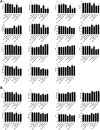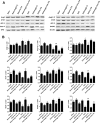Angiotensin (1-7) ameliorates the structural and biochemical alterations of ovariectomy-induced osteoporosis in rats via activation of ACE-2/Mas receptor axis
- PMID: 28536469
- PMCID: PMC5442122
- DOI: 10.1038/s41598-017-02570-x
Angiotensin (1-7) ameliorates the structural and biochemical alterations of ovariectomy-induced osteoporosis in rats via activation of ACE-2/Mas receptor axis
Abstract
The local and systemic renin angiotensin system (RAS) influences the skeletal system micro-structure and metabolism. Studies suggested angiotensin 1-7 (Ang(1-7)) as the beneficial RAS molecule via Mas receptor activation. This study examines the function of Ang(1-7) in bone micro-architecture and metabolism in an ovariectomized (OVX) rodent model of osteoporosis. OVX rats showed structural and bone metabolic degeneration in parallel with suppressed expressions of the angiotensin converting enzyme-2 (ACE-2)/Ang(1-7)/Mas components. The infusion of Ang(1-7) markedly alleviated the altered bone metabolism and significantly enhanced both trabecular (metaphyseal) and cortical (metaphyseal-diaphyseal) morphometry. Urinary and bones minerals were also improved in OVX rats by Ang(1-7). The infusion of the heptapeptide enhanced ACE-2/Mas receptor expressions, while down-regulated AngII, ACE, and AngII type-1 receptor (AT1R) in OVX animals. Moreover, Ang(1-7) markedly improved osteoprotegerin (OPG) and lowered receptor activator NF-κB ligand (RANKL) expressions. The defensive properties of Ang(1-7) on bone metabolism, structure and minerals were considerably eradicated after blockage of Mas receptor with A-779. Ang(1-7)-induced up-regulated ACE-2/Ang(1-7)/Mas cascade and OPG expressions were abolished and the expressions of ACE/AngII/AT1R and RANKL were provoked by A-779. These findings shows for the first time the novel valuable therapeutic role of Ang(1-7) on bone health and metabolism through the ACE-2/Mas cascade.
Conflict of interest statement
The authors declare that they have no competing interests.
Figures





Similar articles
-
ACE-2/Ang1-7/Mas cascade mediates ACE inhibitor, captopril, protective effects in estrogen-deficient osteoporotic rats.Biomed Pharmacother. 2017 Aug;92:58-68. doi: 10.1016/j.biopha.2017.05.062. Epub 2017 May 19. Biomed Pharmacother. 2017. PMID: 28531801
-
The ACE-2/Ang1-7/Mas cascade enhances bone structure and metabolism following angiotensin-II type 1 receptor blockade.Eur J Pharmacol. 2017 Jul 15;807:44-55. doi: 10.1016/j.ejphar.2017.04.031. Epub 2017 Apr 22. Eur J Pharmacol. 2017. PMID: 28442323
-
Angiotensin-converting enzyme 2/angiotensin-(1-7)/Mas axis protects against lung fibrosis by inhibiting the MAPK/NF-κB pathway.Am J Respir Cell Mol Biol. 2014 Apr;50(4):723-36. doi: 10.1165/rcmb.2012-0451OC. Am J Respir Cell Mol Biol. 2014. PMID: 24168260
-
Angiotensin-(1-7): beyond the cardio-renal actions.Clin Sci (Lond). 2013 Apr;124(7):443-56. doi: 10.1042/CS20120461. Clin Sci (Lond). 2013. PMID: 23249272 Review.
-
Recent advances in the angiotensin-converting enzyme 2-angiotensin(1-7)-Mas axis.Exp Physiol. 2008 May;93(5):519-27. doi: 10.1113/expphysiol.2008.042002. Epub 2008 Feb 29. Exp Physiol. 2008. PMID: 18310257 Review.
Cited by
-
The Tissue Renin-Angiotensin System and Its Role in the Pathogenesis of Major Human Diseases: Quo Vadis?Cells. 2021 Mar 15;10(3):650. doi: 10.3390/cells10030650. Cells. 2021. PMID: 33804069 Free PMC article. Review.
-
Diminazene aceturate or losartan ameliorates the functional, radiological and histopathological alterations in knee osteoarthritis rodent model: repurposing of the ACE2/Ang1-7/MasR cascade.J Exp Orthop. 2023 Oct 25;10(1):107. doi: 10.1186/s40634-023-00673-1. J Exp Orthop. 2023. PMID: 37878123 Free PMC article.
-
Repurposing losartan potassium against rheumatoid arthritis via transdermally-delivered leciplexes: Accentuated efficacy through modulation of angiotensin II/AT1R/AT2R axis.Int J Pharm X. 2025 Jul 5;10:100354. doi: 10.1016/j.ijpx.2025.100354. eCollection 2025 Dec. Int J Pharm X. 2025. PMID: 40688027 Free PMC article.
-
Exogenous Angiotensin-(1-7) Provides Protection Against Inflammatory Bone Resorption and Osteoclastogenesis by Inhibition of TNF-α Expression in Macrophages.Calcif Tissue Int. 2024 Oct;115(4):432-444. doi: 10.1007/s00223-024-01257-6. Epub 2024 Jul 19. Calcif Tissue Int. 2024. PMID: 39030433 Free PMC article.
-
Angiotensin(1-7) attenuates tooth movement and regulates alveolar bone response during orthodontic force application in experimental animal model.Prog Orthod. 2023 Oct 16;24(1):33. doi: 10.1186/s40510-023-00486-z. Prog Orthod. 2023. PMID: 37840086 Free PMC article.
References
-
- Nie, W. et al. Angiotensin-(1-7) enhances angiotensin II induced phosphorylation of ERK1/2 in mouse bone marrow-derived dendritic cells. Mol Immunol46, 355–361, doi:S0161-5890(08)00739-6 (2009). - PubMed
-
- Hiruma, Y., Inoue, A., Hirose, S. & Hagiwara, H. Angiotensin II stimulates the proliferation of osteoblast-rich populations of cells from rat calvariae. Biochem Biophys Res Commun230, 176–178, doi:S0006-291X(96)95914-8 (1997). - PubMed
Publication types
MeSH terms
Substances
LinkOut - more resources
Full Text Sources
Other Literature Sources
Medical
Miscellaneous

